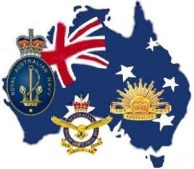
The Late Rear Admiral Guy Richmond Griffiths – A Life of Service and Legacy in the Royal Australian Navy
The Late Rear Admiral Guy Richmond Griffiths, AO, DSO, DSC (1 March 1923 – 5 March 2024), stands as a remarkable figure in the history of the Royal Australian Navy (RAN). His century-long life, marked by extraordinary bravery, leadership, and service, reflects the dedication and resilience of a man deeply committed to his country. Griffiths’ military career spanned pivotal moments in global history, including World War II, the Korean War, and the Vietnam War. Beyond his military achievements, Griffiths continued to serve his nation and fellow veterans well into his retirement. His passing at the age of 101 marks the end of an era, but his legacy endures as a testament to the enduring spirit of the Australian Navy.
Early Life and Naval Beginnings
Born on 1 March 1923 in Sydney, New South Wales, Guy Richmond Griffiths grew up in the Hunter Valley, a region known for its rich history and rugged landscapes. His early life was shaped by the values of duty and discipline, which would later define his military career. In 1937, at the age of 14, Griffiths entered the Royal Australian Naval College as a cadet midshipman, beginning a journey that would see him rise through the ranks of the RAN and earn distinction in multiple theatres of war.
World War II and the Sinking of HMS Repulse
Upon graduating from the Naval College, Griffiths was posted to the Royal Navy for further training. It was during this time that he joined the battle cruiser HMS Repulse, a ship that would play a tragic role in his early career. On 10 December 1941, HMS Repulse, alongside HMS Prince of Wales, was sunk by Japanese air attack off the coast of Malaya. The loss of these ships was a significant blow to the Allied forces in the Pacific, but Griffiths, then a young midshipman, survived the ordeal. The experience of the sinking, with its profound loss of life, would leave an indelible mark on him, shaping his resolve and commitment to service.
Following the sinking of Repulse, Griffiths continued to serve with distinction in the Royal Navy and later the Royal Australian Navy. He was promoted to lieutenant in 1944 and soon after was awarded the Distinguished Service Cross (DSC) in May 1945 for his gallantry, skill, and devotion to duty during the successful assault operations in the Lingayen Gulf, Luzon Island, while serving aboard HMS Shropshire. This recognition highlighted Griffiths’ courage and leadership during some of the most challenging naval battles of the war.
Post-War Service: Korean and Vietnam Wars
After World War II, Griffiths’ career continued to ascend as he took on more significant roles within the RAN. During the Korean War, he served as the Gunnery Officer on HMAS Sydney, contributing to the ship’s operations in the conflict. His expertise in naval warfare and leadership skills were further recognized when he was given command of the guided missile destroyer HMAS Hobart during the Vietnam War. Under his command, HMAS Hobart played a critical role in naval operations, demonstrating Griffiths’ tactical acumen and ability to lead in complex and dangerous situations.
One of the defining moments of his post-war career came in 1974 when Griffiths, then commander of HMAS Melbourne, was called upon to assist in relief operations following the devastation wrought by Cyclone Tracy in Darwin. The cyclone had caused widespread destruction, and Griffiths’ leadership in the relief efforts showcased his dedication to helping those in need, whether in war or peace.
Leadership Roles and Retirement
In 1976, Griffiths was promoted to rear admiral and appointed Chief of Naval Personnel, a role that placed him in charge of managing the careers and welfare of RAN personnel. His experience and deep understanding of the Navy made him well-suited for this position, where he influenced the development and support of the Navy’s human resources during a time of significant change.
In January 1979, Griffiths took up his final posting as the Flag Officer Naval Support Command. This role, which he held until his retirement in 1980, saw him overseeing the logistical and operational support for the entire Navy, ensuring that the RAN remained ready and capable of fulfilling its mission.
Post-Military Contributions and Legacy
Following his retirement from active service, Griffiths did not fade into the background. Instead, he continued to contribute to the Australian community and the welfare of his fellow veterans. From 1980 to 1983, he served as the personnel director of Wormald International, bringing his leadership skills to the corporate world. Simultaneously, he was deeply involved in veteran affairs, serving as the national president of the Australian Veterans and Defence Services Council from 1980 to 2004. In this role, Griffiths was a tireless advocate for the rights and recognition of veterans, ensuring that their sacrifices were not forgotten.
Conclusion
Rear Admiral Guy Richmond Griffiths passed away on 5 March 2024 at the age of 101, leaving behind a legacy of service, bravery, and leadership that spanned more than six decades. His life is a powerful reminder of the sacrifices made by those who serve in the armed forces and the enduring impact they have on their country. Griffiths’ story is not just one of military achievement, but also of a lifelong commitment to the principles of duty, honour, and service to others. His legacy will continue to inspire future generations of Australian naval officers and serve as a beacon of the values that define the Royal Australian Navy.




At the end of a long day cleaning up after cyclone Tracey hundreds of sailor lounged around waiting for their transport back to their ships. On one particular day a car pulled up and a Lieutenant Commander jumped out and aggressively and repeatedly called for the person in charge of the rabble laying about of the verge of the road. A white overall clad officer stepped forward and said; “I suppose that would be me,” And “Who are you?”, screeched the belligerent two and a half. Rear Admiral Griffith came the nonchalant reply.
The exchange was classic and brightened the day of the troops no end.